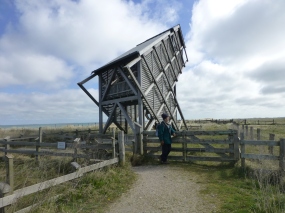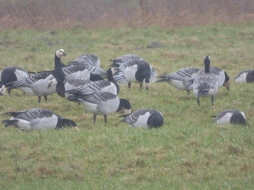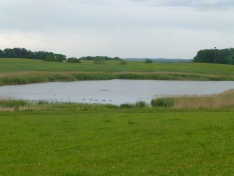 Fehmarn is a small German island lying in the western end of the Baltic sea. A bridge connects it to the mainland, Its position, just south of Denmark, means that it is well placed to receive autumn migrants coming south. The north coast is especially good for raptors and waders.
Fehmarn is a small German island lying in the western end of the Baltic sea. A bridge connects it to the mainland, Its position, just south of Denmark, means that it is well placed to receive autumn migrants coming south. The north coast is especially good for raptors and waders.
Roger White. Ken Hall and Robin Prytherch flew from Bristol to Hamburg and travelled north in a hire car to Burg auf Fehmarn which is the main town on the island.
Over the next 4 days we explored the main sites. These included Gruenebrink and Markelsdorfer Huk on the north coast, Sulsdorfer Wiek in the south and Staberhuk at the south east tip.

The point at Staberhuk
Raptor numbers were relatively small with just a few Honey Buzzards, Ospreys and Marsh Harriers. Sparrowhawks were watched coming in across the sea from Denmark but again the numbers were small. Four White-tailed Eagles were probably local birds. Interestingly the number of raptors passing through the famous migration site of Falsterbo north east of here at the tip of Sweden were unusually low for the time of year, so clearly we had not picked the best weekend.
However, we were more than compensated by the number and variety of waders. One or two were missed but nevertheless the count of 23 species of wader (“Limi” as the Germans call them) was impressive . We met a number of German Birders and found them invariably friendly and helpful. It was a challenge for some of them to practise their English but more of a challenge for us to practise our German! Fortunately Roger remembered most of the bird names in German so this formed a good basis for conversation!

Gruenebrink
Gruenebrink was especially productive this year because the water levels in the lagoons were ideal. The other coastal sites were relatively disappointing for shore birds whereas previously they had been very productive.
The main memories were the huge numbers of Golden Plover, good numbers of Ruff, Spotted Redshank and Wood Sandpiper, and both Little and Temminck’s Stint. A Red-necked Phalarope on

Protected beach at Gruenebrink
day one was joined by another the following day. The German name for this is Odinshuehnchen (Odin’s chicken). I have yet to find out the derivation of this name. A Caspian Tern was seen at 2 sites, and there were good numbers of Cranes at Sehlendorfer See on the mainland.
On the sea were Common Scoter, Eider and Red-breasted Merganser, and a single Arctic Skua strayed into one of the lagoons, chasing a tern.
Passerines were few, but Crossbills and a Red-backed Shrike were nice to see and there

A few of the thousands of Golden Plover
were a lot of Yellow Wagtails. The inland fields, hedges and woodland were very quiet, and there were remarkably few birds in the villages. At Staberhuk, near the lighthouse there were Spotted and Pied Flycatchers and a lot of Chiffchaffs.
There were some unexpected absences, incuding Blackbird! but we counted a total of 100 species over the four days.
Roger White
Full details of the sites mentioned and other sites in northern Germany will be in the forthcoming new edition of the book:
“A Birdwatching Guide to North East Germany and its Baltic coast”



 raswarder peninsula at Heiligenhafen, Sehlendorfer See, Oldenburger Bruch, Barkauer See, Neustadt, the coast near Grömitz, and Rupersdorfer See at Lübeck.
raswarder peninsula at Heiligenhafen, Sehlendorfer See, Oldenburger Bruch, Barkauer See, Neustadt, the coast near Grömitz, and Rupersdorfer See at Lübeck. he Baltic side and salt marsh on the ‘inland side.’ It is a NABU protected site, where breeding species include Common Gull, Little, Common, Arctic and Sandwich Tern, Avocet, Redshank. A tall hide gives views over the reserve. Sehlendorfer See is a wetland west of Heiligenhafen close to Lütjenburg. Viewing is better than at Graswarder and there is a good observation platform from where breeding Avocets, and a Common Tern platform can be viewed.White-tailed Eagles breed nearby.
he Baltic side and salt marsh on the ‘inland side.’ It is a NABU protected site, where breeding species include Common Gull, Little, Common, Arctic and Sandwich Tern, Avocet, Redshank. A tall hide gives views over the reserve. Sehlendorfer See is a wetland west of Heiligenhafen close to Lütjenburg. Viewing is better than at Graswarder and there is a good observation platform from where breeding Avocets, and a Common Tern platform can be viewed.White-tailed Eagles breed nearby.
 After the evening flight from Bristol to Hamburg (BMI) we travelled north to Tönning which is an attractive old harbour town on the River Eider. This was the base for the next 3 nights. Nearby, and just inland from the North Sea is Katinger Watt, a large wetland reserve. Among the wildfowl were 5 Smew (4 drakes) and a raft of Goldeneye. There is a large barrier across the mouth of the Eider as it
After the evening flight from Bristol to Hamburg (BMI) we travelled north to Tönning which is an attractive old harbour town on the River Eider. This was the base for the next 3 nights. Nearby, and just inland from the North Sea is Katinger Watt, a large wetland reserve. Among the wildfowl were 5 Smew (4 drakes) and a raft of Goldeneye. There is a large barrier across the mouth of the Eider as it  enters the North Sea. The tide was low and on the extensive mud were Shelduck and Curlew. The first geese in any numbers were found on the coast just north of St Peter-Ording. Several hundred Barnacle Geese with a few Greylags were feeding in the wet meadows. The beach and the dunes here are a protected site for breeding waders, especially for Ringed and Kentish Plover.
enters the North Sea. The tide was low and on the extensive mud were Shelduck and Curlew. The first geese in any numbers were found on the coast just north of St Peter-Ording. Several hundred Barnacle Geese with a few Greylags were feeding in the wet meadows. The beach and the dunes here are a protected site for breeding waders, especially for Ringed and Kentish Plover. surrounding lowland are protected areas for breeding waders, the most threatened being Black-tailed Godwit. In some meadows nearby was a flock of 70+ Whooper Swan together with a mixed flock of geese. These were mainly Greylags but in addition were, Barnacles, White-fronts and a few Bean Geese. Next stop at The
surrounding lowland are protected areas for breeding waders, the most threatened being Black-tailed Godwit. In some meadows nearby was a flock of 70+ Whooper Swan together with a mixed flock of geese. These were mainly Greylags but in addition were, Barnacles, White-fronts and a few Bean Geese. Next stop at The  polder areas around Beltringharder Koog, north of Husum was where goose flocks were now in thousands, and Brent Goose was added to the list. There is a large observation tower here. Suddenly
polder areas around Beltringharder Koog, north of Husum was where goose flocks were now in thousands, and Brent Goose was added to the list. There is a large observation tower here. Suddenly  there were huge numbers
there were huge numbers  of geese, duck and waders – mainly Curlew, Grey and Golden Plover – in the air. A search for the cause quickly revealed a juvenile White-tailed Eagle flapping slowly north.
of geese, duck and waders – mainly Curlew, Grey and Golden Plover – in the air. A search for the cause quickly revealed a juvenile White-tailed Eagle flapping slowly north. near the mill. On the large lagoon and the adjacent shore were large numbers of waterfowl, which included Greylag Geese, Eider, Scaup, Red-breasted Merganser, Wigeon, Shoveler and Pintail. On the eastern side of the
near the mill. On the large lagoon and the adjacent shore were large numbers of waterfowl, which included Greylag Geese, Eider, Scaup, Red-breasted Merganser, Wigeon, Shoveler and Pintail. On the eastern side of the  peninsula were more Eider, Common Scoter, Mergansers, Goldeneye and good numbers of Barnacle and White-fronted Geese on the wet meadows. Lapwings were the only waders.
peninsula were more Eider, Common Scoter, Mergansers, Goldeneye and good numbers of Barnacle and White-fronted Geese on the wet meadows. Lapwings were the only waders. The whole of the North Sea coast from Husum to the Danish border is flat with a long dyke, behind which are the polders (Koogs), a lot of which are preserved wetlands, with marsh, reedbeds and extensive stretches of open water. We looked at Rickelsbüller Koog, Hauke Haien Koog and Beltringharger Koog. As we
The whole of the North Sea coast from Husum to the Danish border is flat with a long dyke, behind which are the polders (Koogs), a lot of which are preserved wetlands, with marsh, reedbeds and extensive stretches of open water. We looked at Rickelsbüller Koog, Hauke Haien Koog and Beltringharger Koog. As we ll as huge numbers of geese, and a lot of duck, there were large flocks of waders. The highlights included 20,000 + Barnacles, Whooper and Bewick Swans, Pink-footed and Brent Geese, Smew, and enormous wader flocks coming inland on the rising tide, mostly Dunlin, Grey and Golden Plover, Oystercatchers, Avocets. On the salt marsh were small flocks of Twite.
ll as huge numbers of geese, and a lot of duck, there were large flocks of waders. The highlights included 20,000 + Barnacles, Whooper and Bewick Swans, Pink-footed and Brent Geese, Smew, and enormous wader flocks coming inland on the rising tide, mostly Dunlin, Grey and Golden Plover, Oystercatchers, Avocets. On the salt marsh were small flocks of Twite. journey to Hamburg during further stops on the Baltic coast we added , Slavonian and Red-necked Grebe, Goosander, more Smew, Long-tailed Duck and a Short-eared Owl which flew in from the sea.
journey to Hamburg during further stops on the Baltic coast we added , Slavonian and Red-necked Grebe, Goosander, more Smew, Long-tailed Duck and a Short-eared Owl which flew in from the sea.
















![Great-Bustard-flock-Germany_4496[1]](https://germanybirding.files.wordpress.com/2015/06/great-bustard-flock-germany_44961.jpg?w=321&h=214)
![Common-Cranes_4525[1]](https://germanybirding.files.wordpress.com/2015/06/common-cranes_45251.jpg?w=265&h=176)
![Sea-Eaglr_4619[1]](https://germanybirding.files.wordpress.com/2015/06/sea-eaglr_46191.jpg?w=263&h=175)
![Bean-Geese-juvs_4737[1]](https://germanybirding.files.wordpress.com/2015/06/bean-geese-juvs_47371.jpg?w=281&h=187)